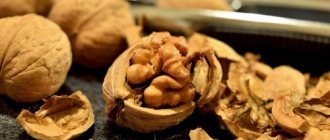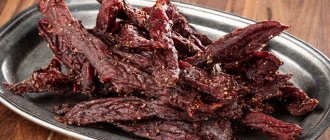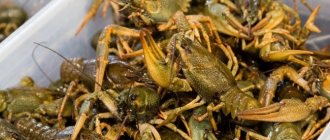Horseradish root is known for its unique medicinal properties and pronounced taste, which perfectly complements meat dishes. Thrifty housewives know how to store horseradish at home so that it remains spicy and aromatic until spring, or even until the next harvest. The plant is eaten fresh and dried, used in tinctures and preservation. From this article you will learn how to store horseradish.
Horseradish root and leaves are used in tinctures and preservation
Storing fresh horseradish
It is best to store horseradish fresh for the winter.
In an apartment, the roots can be stored on a glassed-in balcony laid in sand. You can also use peat bedding. The roots laid out in containers are sprinkled with peat. This material has antiseptic properties that protect root crops from rot.
Suitable temperature is 0...+3 degrees Celsius, humidity should be 80-90%. Fresh horseradish can be stored for a long time only in a well-ventilated area.
Selection and sorting of raw materials
You should dig up horseradish from the autumn harvest, and, accordingly, go to the market for a supply in mid-October or early November. Root crops collected after this period lose their juiciness. As a result, not only the taste of the product suffers, but also its keeping quality; such fruits dry out faster during storage. When purchasing horseradish, you should ask the seller to allow you to break one root - if it is brittle, it means that the root crop was left in the ground.
For culinary purposes, the roots of three-year-old plants are best suited: young horseradish does not have the required “hotness,” and old fruits become tasteless and acquire an excessively fibrous, “woody” structure. The root of the required age is about 2 cm in diameter.
You need to carefully remove horseradish from the soil so as not to cut it. The cut points will open the fungi into the fetal tissue, which can lead to rapid spoilage of the product. For long-term fresh storage, only healthy, succulent roots that are not affected by pests or diseases should be left. The pulp of the root vegetable should have a uniform white color, and the skin should have an even and light yellowish tint. There should be no traces of impacts, cracks, signs of rotting or mechanical damage on the surface of the fruit.
On a note!
Roots that are cut during digging, too small, or rejected for other reasons can be left for storage after processing.
In pureed form
Before freezing, horseradish can be ground using a blender or in a meat grinder. It is difficult to grate the root: it will sting your eyes. To avoid eye irritation, it is advisable to place a plastic bag over the outlet of the meat grinder.
Read more ► How and where to properly store potatoes: 5 ways
The “safest” option is to process the raw materials in a food processor or blender. The roots are hard, so the power of the device should be at least 600-700 W.
Where to store horseradish in jars
There are many recipes for processing horseradish that allow you to fully use it. Salting and marinating will take time, but the beneficial substances will last longer.
Preparing horseradish in jars for the winter
Option 1
To prepare twisted horseradish in jars, take: 250 ml of water, 1 tbsp. l. sugar and salt.
- peel and chop 1 kg of horseradish;
- boil water, add sugar and salt;
- add the grated roots, stir;
- place in jars with nylon lids.
The product is stored at a temperature no higher than +5 degrees for 1-2 months. Before serving, dilute with sour cream in a 2:1 ratio.
To preserve it for a longer period, add 125 ml of apple cider vinegar to the base and only then the twisted horseradish itself. When preparing this way, jars should be sterilized, filled and closed with tin lids.
With this preparation, the shelf life of the product reaches several years.
Option 2
To prepare a seasoning based on horseradish (horseradish), add to a volume of 200 g: salt 1 tsp, sugar 1 tbsp, wine vinegar 7 tbsp, ground beets 1 pc.
- chop the roots (preferably juicy and thin);
- Divide the resulting liquid slurry into jars and place in the refrigerator.
The shelf life reaches 3-6 months.
Maintain a power of 600-700 Watts, otherwise hard rhizomes will not be able to turn. When handling, protect your eyes, nose, and respiratory tract.
As a dry spice
First, the root is peeled, washed and peeled. After this, the root is crushed and dried in the oven over low heat. Well-dried raw materials can be easily ground in a coffee grinder.
The resulting powder is poured into a glass container and stored in a cool place. Dry powder is used as a preventive measure against mold during preservation.
Dry horseradish is good to add to sauces
If you add one tablespoon of dried root to the brine for cucumbers, then fungus will not appear in it and it will not become cloudy. The powder is also added to already opened jars of canned vegetables: this way they are stored longer without mold.
Dry horseradish is good to add to sauces (for example, adjika) to add a piquant taste.
Each method of storing horseradish root has its own subtleties:
- If the roots will be stored in the refrigerator, they are first washed and thoroughly dried. To increase shelf life, they should not be cleaned.
- Frozen vegetables can be stored in the freezer for about a year. You can freeze both whole and ground roots. Be sure to wash and dry them before storing.
- Drying is an effective storage method. The roots can be dried by simply laying them out in the shade, but it is better to do this in the oven. The washed root vegetables are cut into small pieces and laid out in one layer on a baking sheet, dried for 1.5-2 hours while maintaining a temperature in the oven of up to 60 degrees Celsius. After drying, it is better to store the root in cloth bags or glass jars. You can make seasoning from it by simply grinding it.
How to store grated, prepared horseradish for the winter?
Already prepared, heat-treated horseradish, horseradish must be stored at a temperature of 6 degrees.
Tips on how to store horseradish:
- The shelf life is 6 months. However, care should be taken to ensure that no air is exposed to the spice to prevent the formation of mold.
- For the same purpose, a small layer of oil can be poured on top, which blocks any air access to the finished product. It is necessary to adhere to some subtleties in preparing products for long-term storage.
- If you freeze horseradish roots , then it is best to do this with those that are not suitable for long-term storage in the cellar. For the purpose of freezing, it is necessary to wash the roots, remove any dirt, and cut into portions.
- After this, the products are loaded into plastic containers or plastic bags with a zipper. Then, as needed, individual pieces of the product are defrosted. If it is necessary to grind them, the roots are grated frozen, because this is how they do not bake and do not cause tearing. Of course, it is worth noting that the taste quality may decrease and the taste of horseradish that has been previously frozen may change slightly.
In the cellar or basement
Attention! Horseradish is well stored in a cellar or basement along with other vegetables. With such a bookmark, less labor will be required and the internal space of the room can be saved.
Horseradish will last until spring if you think about arranging storage in advance. It is necessary to thoroughly clean the cellar, remove the remains of rotten vegetables, whitewash the ceiling and walls, and treat the shelves and drawers from putrefactive bacteria.
An effective method is to use smoke bombs, but you must remember that this treatment requires at least 2 weeks of storage before adding food.
If the basement is ready, you can store root vegetables:
- Prepare the required number of boxes.
- Pour sand, dry sawdust or peat into the bottom of the container, and place the roots on this bedding so that they do not touch each other.
- Fill the first layer and continue laying the roots, covering them with sand or sawdust.
Read more ► Storing onions, sets and leeks in an apartment or at home in winter
During storage, fruits must be inspected once a month. All rotten or diseased ones must be removed immediately, as they can cause damage to the rest of the horseradish.
If the roots begin to dry out too much, you need to pour wet sand into the box, otherwise the vegetable will become flabby. Alternative storage method: Unpeeled, dried roots are tied into loose bunches and hung from the ceiling.
This kind of horseradish dries quickly, but it is convenient to do this if the workpiece is small: you can save space in the basement.
Preparing horseradish for winter
If you want to preserve a fragrant vegetable in winter, it must be properly collected and prepared. Dig up the roots in late autumn after the end of the growing season. The best period for harvesting is October and early November; the ground should not be frozen. Cleaning is carried out in dry weather. You can stock up on horseradish leaves until frost.
Use a fork to dig to avoid damaging the plant. In dense soil you will have to use a shovel. It is recommended to remove rhizomes about 10-15 cm in size, otherwise their storage will be ineffective. Shake off the soil and cut off the tops. Roots that are supposed to be stored in the cellar are not washed, as this can lead to rotting. Large roots are slightly cleared of lumps of earth, dried for several hours, then planting begins.
Horseradish roots should be dug up only after the plant has already reached two years. During this period, they become thick and long enough for harvesting.
For storage and harvesting, choose exclusively healthy, clean roots without any traces of disease. Otherwise, all the prepared horseradish will spoil.
If you plan to use the seasoning for culinary purposes, choose roots that are two to three years old. They do not yet have increased fibrousness, the roots are tender and juicy.
To keep horseradish longer, you need to treat the cuts with iodine.
Freezing
To store in the freezer, the roots are cleaned, washed thoroughly and lightly dried. Cut into cubes, place in freezer bags or containers, and place in the freezer.
It is difficult to grate the root
It is recommended to store horseradish for about six months, but after defrosting the vegetable will not be so spicy.
Storing grated roll
Twisted or grated horseradish also has a long shelf life, especially since in this form it can be frozen, pickled, dried, or prepared from it into delicious savory dishes and snacks (Figure 5).
Note: To grind the roots, you can use absolutely any device: a meat grinder, a grater or a blender, but it should be borne in mind that the substances that are released during grinding strongly irritate the mucous membrane.
To ensure that the grinding process does not cause discomfort, you need to properly prepare for it. Firstly, it is advisable to soak the roots overnight in clean water. Secondly, you need to put a gauze bandage on your face to prevent irritation of the mucous membrane. If you use a meat grinder for chopping, cover it with a bag or plastic wrap (Figure 6).
Figure 5. Technology for grinding the root in various ways
Chopped horseradish root can be an excellent base for preparing savory snacks:
- The classic snack is prepared like this: add salt and sugar to taste to the grated vegetable, pour in a little vinegar and sterilize in a water bath for 5 minutes. After this, the snack can be hermetically sealed with metal lids.
- Ogonyok is another spicy dish that can be prepared from the root. For this you will need 300 grams of chopped root, 100 grams of garlic and 1 kg of tomatoes. All vegetables must be minced, add salt, sugar and vinegar. The mixture is thoroughly mixed, poured into jars, covered with nylon lids and stored in the refrigerator.
- With beets: another good option for preserving the root. To do this, you need to chop the roots in any convenient way, pour boiling water and cover with a lid. As a result, you should get 500 grams of raw materials. When the water has cooled, it is drained, and a tablespoon of salt, sugar and half a glass of six percent vinegar are added to the vegetable. Next, you need to boil and grate 300 grams of beets, which are also added to the mixture. The appetizer is thoroughly mixed, placed in jars and covered with lids. If you use nylon lids, it is better to store the appetizer in the refrigerator, and when sealed with metal lids, the horseradish and beets can be left at room temperature.
Figure 6. Options for savory snacks (from left to right): classic, “Ogonyok” and horseradish with beets.
In addition, horseradish can be mixed with sour cream to get a moderately spicy snack. To do this, 300 grams of grated root should be mixed with 2.5 cups of sour cream, add salt and sugar to taste, put into jars, cover with nylon lids and put in the refrigerator for storage.
The detailed preparation of a delicious spicy horseradish snack is shown in the video.
Drying
Roots that are not suitable for long-term storage are dried.
They are cleaned of soil residues, the tops are removed, and small roots are cut off. After this, they are washed and the skin is removed. It is not recommended to soak horseradish roots before drying: they absorb moisture well.
After washing, they are blotted with paper towels and air dried in the shade until completely dry. You can’t dry them in the sun: in such conditions they lose a lot of useful substances.
The “safest” way to process raw materials is in a food processor or blender
Drying is carried out in different ways:
- After cleaning, the roots are cut lengthwise and placed on a baking sheet in one layer. After this, the baking sheets are placed in the oven and the temperature is set to 50-60 degrees Celsius; in such conditions, with the door open, the horseradish is kept for 40-90 minutes. After drying, the roots are stored in glass containers.
- After cleaning, the roots are cut into slices no thicker than 5 mm and similar to the previous method. The dried cuts can be stored in a glass container or ground in a blender.
- After cleaning, the roots are grated on a medium grater, spread in a thin layer on a baking sheet and dried in the oven. The dry mass is poured into jars.
It is believed that horseradish must be peeled to white pulp, completely removing the top layer from the root vegetable. You shouldn’t do this: the peel contains many useful substances, for this reason it is advisable to peel off a thin layer of skin.
Harvesting and root selection
Horseradish is a perennial crop. To preserve its harvest, you need to choose the right roots. They must be free from mechanical damage, solid, undeformed, and without signs of disease. A healthy root vegetable should be yellow or light brown in color. The pulp should be snow-white when cut.
To make a long-lasting aromatic sauce from horseradish, you need to grow special varieties, for example:
- late ripening - Valkovsky;
- mid-season - Atlant.
For long-term storage, 2-3-year-old rhizomes with a thickness of at least 20 cm are suitable.
Harvesting horseradish depends on the variety. As a rule, this occurs in October-November. In late autumn, after the first frost, the bush is dug up very carefully, as the roots become brittle and very vulnerable.
Harvesting is carried out in the following cases:
- The degree of maturity can be determined by the foliage; it turns yellow and dries out.
- Before digging up the bush, cut off all the leaves.
- Use a pitchfork to pry up the root and remove large specimens. Small roots are left in the ground until next year.
- The rhizomes are inspected, sorted, the soil is shaken off and left to dry for a day.
Root vegetables without dents, cracks or signs of rot are suitable for long-term storage. The remainder of the foliage is carefully cut off, and the cut area is treated with iodine or brilliant green.
Broken or damaged roots must be recycled immediately.
Cleaning the roots with a steel wool
Using a washcloth, you can remove dirt and effortlessly remove skin from the roots.
Read more ► Storing potatoes in a box to keep vegetables fresh, healthy and tasty
Cleaning steps:
- Soak the horseradish in water in advance.
- Use steel wool to remove dirty skin.
- If necessary, rinse the root vegetable under running water.
- Use a knife to cut the tops off the root vegetables.
The advantage of this method is that the vegetable is washed and peeled at the same time.
But if there is a large amount of stuck soil, you must first soak the fruit in water, and then wash off most of the dirt. Using steel wool is a quick way to clean the roots without hurting your hands while scrubbing.
Storage errors
Storing horseradish has several nuances, ignorance of which can ruin the stock. The most common mistakes:
- Sun drying. Horseradish should not be kept in direct sunlight even for a short time; moreover, it is not recommended to dry the raw material in this way. After digging, horseradish should be dried outdoors in the shade or indoors.
- Waterlogging of sand for storage. If the sand in the box is wet, the root crop will quickly rot. The sand should be slightly damp, crumbling when squeezed into a handful.
- Freeze large portions. A frozen product retains its taste well, but it should be defrosted once. This applies to both fresh roots and horseradish sauce. Therefore, you need to freeze in small portions in order to consume the contents of the package at a time.
- Wet the root before drying. Drying involves washing the horseradish roots, but you need to wash it as quickly as possible so that the fibers of the fruit do not absorb excess moisture, otherwise the raw material will become moldy.
- Powder dampening. Dry horseradish, like other spices, should be kept at a humidity of no higher than 75%. Dampness is fraught with the appearance of mold and spoilage of the product.
Each method of storing horseradish has its drawbacks, but their variety allows you to choose the most convenient option. Horseradish is harvested twice - in autumn and spring, so even a small supply that the freezer can hold will be enough to provide the table with a healthy and tasty addition to the main diet until fresh root vegetables appear on the markets or in your own garden beds.
How do you like the article?
Storing whole roots in the vegetable compartment of the refrigerator
If you don’t have an equipped storage facility, you can put the horseradish in the refrigerator. The temperature and humidity conditions in the vegetable compartment are suitable for storing small crops.
How to store horseradish in the refrigerator? There are two ways:
- Wash the roots thoroughly and dry on a paper towel. After drying, place the roots in a plastic bag and seal tightly. You can use an airtight food container. The freshness of the crop will remain for 8-10 weeks.
- Wrap the unwashed roots, cleared of soil, one at a time, in cling film. Make several ventilation holes, put it on the vegetable shelf. The shelf life will be about 5 months.
When removing seasonings for cooking, inspect them for spoilage. Towards the end of the shelf life, use the spice for preparations.
Do you know that…
When rubbing horseradish, the space is disinfected. Horseradish phytoncides, scattering throughout the room, kill malicious pathogenic microflora, so it is better to prepare an aromatic seasoning during the approaching epidemics of acute respiratory infections.
Grated roots with vinegar
In addition to storing whole roots, housewives recommend grinding them for placing in the refrigerator using various devices. And adding vinegar can significantly extend the shelf life of root vegetables without the need to roll them up with tin lids.
To preserve the taste and aroma of horseradish throughout the winter, you should chop it using a fine grater. If desired, you can twist the root of the plant with a meat grinder or blender. You need to add a little table vinegar to the resulting mass so that the composition becomes homogeneous.
The horseradish and vinegar paste should be placed in small glass jars, tightly closed with nylon lids and stored in the refrigerator. The product can be stored for at least 6 months.
Whole tubers in a bag
The method is similar to the previous one, only thick plastic bags are used as storage containers. The tubers, cleaned of contaminants, are placed in batches of 7-10 in bags with small holes and put in the refrigerator.
The shelf life of horseradish in bags is 1 month.
To preserve root vegetables for a longer period in the refrigerator, you should use vacuum containers and bags. They require the presence of a special pump that removes all air from the container.
The best horseradish recipes
Cooking horseradish at home will allow you to stock up on the hot seasoning for the winter. It is served with aspic, jellied meat, jelly, homemade sausages and other dishes.
Horseradish in Russian
For a long time, preparing horseradish according to the classic recipe has been very popular. For horseradish in Russian we will need:
Horseradish root (1 kg) is peeled and washed. Grate it on a fine grater or grind it in a meat grinder. Add salt (1 tbsp), sugar (3 tbsp), and boiling water (1 cup). The ingredients are quickly mixed and placed in sterile jars. Add 2-3 drops of lemon juice to each jar on top. If the jars are sealed with canning lids, horseradish will be stored in the refrigerator for up to 3 months.
Classic recipe for Russian horseradish
This horseradish preparation is served either in its pure form or diluted with sour cream in a ratio of 1 to 1. It is an ideal addition to boiled potatoes, jellied meat, jellied meat, and meat dishes.
Horseradish with beets
Beetroot horseradish is a well-known horseradish recipe that can be easily prepared at home even by inexperienced housewives. The seasoning turns out bright, stimulating the appetite.
Horseradish with beet juice with homemade sausage
• Fresh horseradish root (10 pieces medium size);
• Raw beets (1 pc.);
• Salt and sugar to taste;
• Wine or apple vinegar (5-6 tablespoons).
Horseradish and beets are ground on a grater or in a meat grinder. Add salt and sugar to taste, and at the very end - vinegar. If the seasoning is too thick, you can add cold boiled water to the desired consistency. The seasoning is mixed, placed in jars, tightly closed with lids and placed in the refrigerator. This “evil” seasoning will remain for a month.
Advice
If there is no need to store horseradish and beets for a long time, you do not need to add vinegar.
Adjika Khrenoder (horseradish, gorloder)
Cooking horseradish at home, the recipe for which we will now tell you, is popular among lovers of spicy hot sauces.
The process of preparing adjika Chrenoder
It is prepared like this:
• 1 kg of tomato is ground in a meat grinder;
• Next, 300 g of horseradish root and garlic are chopped into a meat grinder or grater;
• Add 1 tbsp. l. salt and sugar and 2-3 tbsp. wine vinegar, or 1-2 tbsp. l. table vinegar 9%;
• The finished sauce is poured into sterile jars and tightly closed with lids.
Store in a cool place.
Recommendation
The proportions of ingredients should be adjusted to your taste. For example, increase the amount of garlic or add more sugar.
Horseradish with apples and carrots
Those who like a milder taste will like the recipe for making horseradish at home with carrots and sour varieties of apples. It is prepared as follows:
• 2 kg of carrots are grated on a fine grater;
• Prepare 100 g in the same way. garlic;
• 100 gr. apples (Antonovka, Semerenko) cut into thin slices;
• Place apples, carrots, horseradish in layers in a jar and fill with marinade.
Delicious and healthy salad with horseradish, carrots, apples
The marinade is prepared like this:
• Boil 1 liter of water with 3 tbsp. sugar and 1 tbsp. salt. At the end add 2 tbsp. vinegar 9%;
• Sterilize prepared jars with salad for 15-20 minutes and roll up.
Freezing grated horseradish
Freezing grated horseradish in the freezer is also allowed. This storage method is convenient because after thawing the vegetable, it will not need to be processed further.
There are several ways to grind root vegetables:
- grate using a hand grater;
- twist in a meat grinder;
- grind using a blender.
Advice! When twisting horseradish in a meat grinder, secure a thick plastic bag to its outlet. This will preserve the aroma and pungency of the spice, and also prevent tearing and burning of the eyes.
The crushed mass is laid out in portioned bags and pressed down to obtain flat pieces that take up a minimum amount of space in the freezer. Another option for freezing horseradish after rolling is placing it in ice trays, then freezing it and pouring it into a bag or container.











